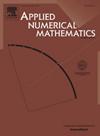A new fast algorithm for computing the mock-Chebyshev nodes
IF 2.2
2区 数学
Q1 MATHEMATICS, APPLIED
引用次数: 0
Abstract
Interpolation by polynomials on equispaced points is not always convergent due to the Runge phenomenon, and also, the interpolation process is exponentially ill-conditioned. By taking advantage of the optimality of the interpolation processes on the Chebyshev-Lobatto nodes, one of the best strategies to defeat the Runge phenomenon is to use the mock-Chebyshev nodes for polynomial interpolation. Mock-Chebyshev nodes asymptotically follow the Chebyshev distribution, and they are selected from a sufficiently large set of equispaced nodes. However, there are few studies in the literature regarding the computation of these points.
In a recent paper [1], we have introduced a fast algorithm for computing the mock-Chebyshev nodes for a given set of Chebyshev-Lobatto points using the distance between each pair of consecutive points. In this study, we propose a modification of the algorithm by changing the function to compute the quotient of the distance and show that this modified algorithm is also fast and stable; and gives a more accurate grid satisfying the conditions of a mock-Chebyshev grid with the complexity being . Some numerical experiments using the points obtained by this modified algorithm are given to show its effectiveness and numerical results are also provided. A bivariate generalization of the mock-Chebyshev nodes to the Padua interpolation points is discussed.
计算模拟切比雪夫节点的新型快速算法
由于 Runge 现象,等距点上的多项式插值并不总是收敛的,而且插值过程是指数条件不良的。利用切比雪夫-洛巴托节点上插值过程的最优性,克服 Runge 现象的最佳策略之一是使用模拟切比雪夫节点进行多项式插值。模拟切比雪夫节点在渐近上遵循切比雪夫分布,而且是从足够大的等距节点集中选择的。然而,文献中有关这些节点计算的研究很少。
本文章由计算机程序翻译,如有差异,请以英文原文为准。
求助全文
约1分钟内获得全文
求助全文
来源期刊

Applied Numerical Mathematics
数学-应用数学
CiteScore
5.60
自引率
7.10%
发文量
225
审稿时长
7.2 months
期刊介绍:
The purpose of the journal is to provide a forum for the publication of high quality research and tutorial papers in computational mathematics. In addition to the traditional issues and problems in numerical analysis, the journal also publishes papers describing relevant applications in such fields as physics, fluid dynamics, engineering and other branches of applied science with a computational mathematics component. The journal strives to be flexible in the type of papers it publishes and their format. Equally desirable are:
(i) Full papers, which should be complete and relatively self-contained original contributions with an introduction that can be understood by the broad computational mathematics community. Both rigorous and heuristic styles are acceptable. Of particular interest are papers about new areas of research, in which other than strictly mathematical arguments may be important in establishing a basis for further developments.
(ii) Tutorial review papers, covering some of the important issues in Numerical Mathematics, Scientific Computing and their Applications. The journal will occasionally publish contributions which are larger than the usual format for regular papers.
(iii) Short notes, which present specific new results and techniques in a brief communication.
 求助内容:
求助内容: 应助结果提醒方式:
应助结果提醒方式:


